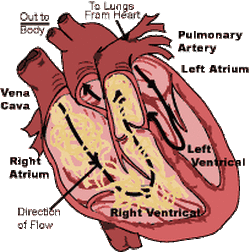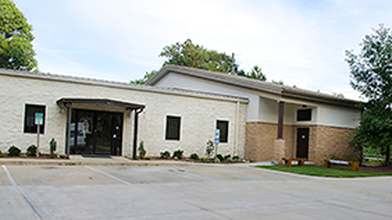Heartworms can inhabit dogs, cats, and ferrets, but dogs are the natural hosts for heartworms. Heartworms that live inside of the dog will mature into adults, mate, and produce offspring. Because the entire life cycle is able to take place within the dog, their numbers can increase if the condition is not treated. Heartworms cause damage while they're living inside of the host animal and this damage can long affect the animal even after treatment. Where do Heartworms Come From? Heartworms are carried from host to host by mosquitos. When a mosquito feeds on an animal infected with heartworms, microscopic baby worms are transferred through the blood into the mosquito. These babies live in the mosquito for ten to fourteen days while they mature into the "infective stage" of larvae. When a mosquito bites the next animal that it feeds on, it transfers the infective larvae through its bite wound. Once this new host is infected, it takes about 6 months for these infective larvae are able to mature into adulthood. Once they reach this stage in the life cycle, they can live for 5 to 7 years in dogs or 2-3 years in cats. What are the Signs of Heartworms in Dogs?  Typically, symptoms in the early stages of heartworm disease are few to none at all. As time goes on and the worms are able to grow and reproduce, more symptoms will begin to develop. Here's what to look for:
What are the Signs of Heartworms in Cats? Cats may occasionally experience difficulty walking, fainting, seizures, or liquid accumulation in the abdomen. Is my Pet in Danger from Heartworms in Alabama? The simple answer to this question is YES! Alabama is able to host high populations of mosquitoes thanks to our warm climate. Wild animals, such as coyotes and foxes, can also carry the disease. With our high populations of mosquitos and wild animals, there is no doubt that this disease is easily able to spread to your pets across the state. How are Heartworms Treated?  Heartworm treatment is difficult on your pet and draining to your bank account, but heartworms are not a death sentence. The first step when you visit your veterinarian is always to get a heartworm test done on your pet. It is an extremely simple test that only requires a few drops of blood and 5 to 10 minutes for the test to be processed. Once this test is completed, your veterinarian will help you to either put your pet on a monthly preventative medication or, if need be, treat your pet for heartworms. If your pet has tested positive for heartworms, an immediate restriction of exercise is required. As these worms reside in your pet's heart, exercise can increase the rate at which damage can be caused to the heart and the lungs. Then your veterinarian will start the actual treatment. Treatment typically involves three rounds of vaccinations, one each month. This vaccine will also be accompanied by blood work and x-rays to monitor your pet's progress. The more severe the pet's heartworm disease is, the more dangerous and draining treatment will be. Finally, once all of the heartworms have been killed, your vet will put your pet on heartworm prevention in order to keep them healthy in the future. In conclusion, heartworm disease is a danger that should be avoided at all costs. In order to keep your pet safe year round, ask your vet about a monthly heartworm preventative. This medication could be the difference between life and death for your pet. Options for Heartworm Prevention At Saugahatchee Animal Hospital, we have multiple recommendations for heartworm prevention for your pet. Here are a few of the products that we carry.
If you have any questions or concerns about heartworm prevention, heartworm testing, heartworm treatment, or heartworms in general, please do not hesitate to contact us!
4 Comments
Animal Shelters An animal shelter may be the first place that you think of when you hear the phrase "adopt a pet". Animal shelters provide a great service to the local community by not only providing temporary housing for stray or unwanted animals, but also by providing them with a new forever home! When a shelter receives an animal either through animal control picking it up or an owner surrendering it for various reasons, there are immediately processed. This includes being fed, watered, and housed, along with being provided with vaccinations and other medical treatments that are necessary. The animal is also spayed or neutered before it is allowed to leave the facility with a new family. Shelters receive a variety of animals, from dogs and cats to pocket pets (such as hamsters) and reptiles. So, no matter which type of animal you are interested in, it can be found at a shelter near you!  The adoption process and prices of adoption differ from facility to facility as each animal shelter is its own company with its own policies. Generally, when you visit a shelter to look into adoption, you will be able to roam around the facility and see all of the animals that they have available. Some facilities will allow you to walk directly through the kennels while others have windows into the kennels through which you can see all of the pets. Once you find an animal that you wish to meet, you will fill out some paperwork and you'll get some time to play and get to know the pet's personality. At the majority of shelters, you will be able to adopt that day if you should wish. Some facilities will allow you to place a 24-hour hold on the animal if you need some more time to make a decision without the pressure of adopting before someone else does. Other shelters will allow you to adopt an animal, but it will need to have a few medical procedures before you physically take them home, including a spay/neuter or vaccinations. At this point the animal is promised to you, but cannot leave the facility until it is in the medical state to do so. Each shelter is different and has different policies, so research is key before your visit. Near the end of this article, we have posted a list of shelters in the state of Alabama. If you so wish, you can click on the image or name there to be taken directly to that shelter's personal website. There you can find out more about the shelter, its policies for adoption, and the animals that they have available for adoption. Animal Rescues Animal rescues are a little different than the animal shelters described above. They are also private facilities who provide adoption services, but they are typically run by volunteers. They also do not normally get their animals directly from the public; their pets typically are pulled from shelters in their area. These pets will be accepted into the rescue for various reasons including their breed and certain medical problems.
At the end of this article, we have listed some amazing rescues that reside within Alabama. In order to find out more information about each specific rescue and to see some of their adoptable pets, just click on the image or the name of the rescue. Shelter or Rescue: Which is Best for You? Animal shelters and rescues are a little different. One or the other may align better with what you and your family is searching for in a new pet. So, let's compare the two to help you make a decision about which type of facility will fit your needs.
Shelters and Rescues in Alabama Here are some animal shelters in the state of Alabama. To get more information about the shelter itself and to see some of the pets that they have available for adoption, simply click on one of the images below. In order to see some of the rescues in our state, scroll to the end of the article.
Here are some of the wonderful rescues in the state of Alabama. To get more information about the rescue itself and to see some of the pets that they have available for adoption, simply click on one of the images below.
What is Heat Stroke? Heat Stroke (also known as hyperthermia) is an elevation of body temperature above the normal range for your animal. For dogs, the generally accepted rule is that temperatures above 103°F (39°C) are too high. Heat strokes occur when heat-dissipating mechanisms of the body cannot accommodate excessive external heat. This condition can lead to more serious conditions such as multiple organ dysfunction. Certain breeds of dogs and cats are prone to difficult, obstructive breathing because of the shape of their head, muzzle and throat. The most common dogs affected are the “brachycephalic” breeds. Brachycephalic means “short-headed". Common examples of brachycephalic dog breeds include the English bulldog, French bulldog, Pug, Pekingese, and Boston terrier. These dogs have been bred to have relatively short muzzles and noses and, because of this, the throat and breathing passages in these dogs are frequently undersized or flattened. Persian cats also have a brachycephalic conformation. These breeds are more prone to heat strokes than other breeds, so the following prevention measures are especially important for brachycephalic pet owners to be aware of. How do You Prevent Heat Stroke? Heatstroke can be prevented if you are prepared with the knowledge to do so. The following are all great options for keeping your pet's temperature down while enjoying those hot summer days.
What are the Symptoms of Heat Stroke? What Should You do if Your Pet Displays these Symptoms? The most important thing to do if your pet is displaying symptoms of heat stroke is to bring them to a veterinarian as soon as possible! In the mean time, remove them from the hot area immediately. To lower their body temperature, place cool towels over the back of their neck, under the forelimbs, and in the groin area. If possible, try to increase air movement around them with a fan or air conditioning. While cooling your pet, be careful! You are at risk of cooling them off too fast which can cause other dangerous conditions. Their temperature should be checked about every five minutes. Once the body temperature is at 103ºF, immediately stop the cooling process and maintain their current body temperature by making sure they are completely dry and cover them with a blanket or towel. Even if your animal keeps a low temperature and loses symptoms, take them to your veterinarian as soon as possible! They may be dehydrated or have other complications. What Will Your Veterinarian Do? If you bring your pet to the veterinarian while in the midst of their heat stroke, the first thing will be lowering their body temperature safely. Your pet will be given fluids and possibly oxygen if it is deemed necessary. The most important thing that a veterinarian will do is monitor for other conditions associated with a heat stroke, such as shock, respiratory distress, and dehydration along with more severe reactions like kidney failure and heart abnormalities. What do You do When Your Pet Comes Home? Heat stroke is a risk to any pet owner on hot days, but when you're armed with preventative measures, it is nothing to be afraid of. Now go out and enjoy that beautiful summer weather with your furry best friend! Sources: Dr's Foster and Smith. Pet Education. Pet MD. ACVS.
|






















